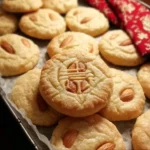Of all the cookies in the world, few are as deceptively simple and profoundly comforting as the Chinese Almond Cookie. For me, they are not just a treat; they are a vessel for nostalgia, a bite-sized piece of tradition. My most vivid memories of these cookies are tied to the vibrant, bustling energy of Lunar New Year. My grandmother would spend a whole afternoon in the kitchen, and the entire house would be filled with the most incredible aroma of toasted almonds and warm butter. She would let me help, my small fingers pressing a single, perfect almond into the center of each pale, round disc of dough. They weren’t like the chewy chocolate chip cookies I knew; they were something else entirely. They were sandy, crumbly, and seemed to melt the moment they hit your tongue, leaving behind a fragrant, nutty sweetness. The finished cookies, with their signature cracked tops and golden sheen, were a symbol of good fortune, meant to resemble coins. Sharing them with family, plucking them from a festive red tin, was as much a part of the celebration as the red envelopes and fireworks. This recipe is my heartfelt tribute to those memories—a way to recreate that specific, wonderful cookie that is both profoundly simple and rich with history and love.
The Timeless Allure of the Chinese Almond Cookie: A Crumbly Bite of History
Welcome to your ultimate guide to mastering the classic Chinese Almond Cookie. This iconic treat is a staple in Chinese bakeries and a beloved fixture during celebrations, especially Lunar New Year. Unlike many Western cookies that are prized for being soft and chewy, the Chinese Almond Cookie is celebrated for its unique and utterly delightful texture: a wonderfully sandy, shortbread-like crumb that is light, crisp, and dissolves in your mouth.
This recipe will demystify the process, showing you how to achieve that perfect texture and the signature fragrant almond flavor from scratch. Forget the bland, mass-produced versions; once you experience the taste of a truly homemade almond cookie, warm from the oven, you’ll understand why this humble treat has been cherished for generations.
What Makes This Cookie So Special?
- Unique Texture: The defining characteristic is its sandy, crumbly, and melt-in-your-mouth texture. It’s achieved through a careful balance of fat, flour, and leavening agents.
- Intense Almond Flavor: A good almond cookie should be bursting with the fragrant, slightly sweet flavor of almonds. This is achieved through a combination of almond flour and high-quality almond extract.
- Symbolism and Tradition: These cookies are traditionally shaped like coins to symbolize good fortune and prosperity, making them an essential part of Lunar New Year festivities. The single almond pressed into the center represents a precious jewel.
- Simple, Accessible Ingredients: Despite their rich history and flavor, these cookies are made from simple, widely available pantry staples.
- Incredibly Satisfying: The combination of the buttery, crumbly cookie and the crunchy toasted almond on top is a simple, yet profoundly satisfying, experience. They are the perfect accompaniment to a cup of tea.
The Anatomy of a Perfect Almond Cookie: Understanding the Key Ingredients
To achieve the signature texture and flavor of a truly authentic Chinese Almond Cookie, it’s important to understand the role each ingredient plays. This isn’t just a recipe; it’s a science of texture.
The Flour: Building the Crumbly Foundation
- All-Purpose Flour: This is the primary structural component of the cookie.
- Almond Flour: This is the secret to a superior cookie. Finely ground blanched almonds, or almond flour, serves two critical purposes. First, it infuses the entire cookie with a deep, natural, nutty almond flavor. Second, because it contains no gluten, it contributes to the signature tender, sandy, and short texture.
The Fat: The Key to a Melt-in-Your-Mouth Texture
The type of fat used has a significant impact on the final cookie.
- Butter: For this recipe, we use unsalted butter. It provides a rich, creamy flavor that is universally loved and creates a wonderfully tender crumb.
- The Traditional Choice (Lard): Historically, Chinese bakeries used lard. Lard has a unique ability to create an incredibly flaky and short texture, which is why it’s also used in traditional Chinese pastries. While authentic, its flavor can be more savory, and it’s less common in modern home kitchens. Butter is a fantastic and more accessible substitute.
- Shortening: Vegetable shortening can also be used. It will produce a very tender and crumbly cookie but lacks the rich flavor of butter.
The Almond Flavor: The Soul of the Cookie
- Almond Extract: This is what gives the cookie its powerful, recognizable aroma and flavor. A high-quality, pure almond extract is essential. Avoid imitation almond flavoring, as it can have a harsh, artificial taste. A little goes a long way, but it is non-negotiable for that classic taste.
The Leavening: Creating the Signature Crack
- Baking Soda and Baking Powder: This recipe uses a combination of both. Baking soda (an alkali) helps the cookies to spread and promotes browning, while baking powder (a complete leavening agent containing both an acid and a base) provides a gentle lift. Together, they help create the characteristic cracks on the surface of the cookie as it bakes.
The Finishing Touches
- The Almond: A single blanched almond pressed into the center is the cookie’s signature decoration. Pressing it in before baking ensures it toasts beautifully and adheres to the cookie.
- The Egg Wash: This is the secret to that beautiful, glossy, bakery-style sheen. A simple wash of egg yolk and water brushed on the cookies before baking gives them a rich, golden color.
Complete Ingredients for Classic Chinese Almond Cookies
Yields: Approximately 24-30 cookies
Prep time: 20 minutes
Chilling time: 1 hour
Cook time: 15-18 minutes
- For the Cookie Dough:
- 1 cup (226g or 2 sticks) unsalted butter, softened to room temperature
- 1 cup (200g) granulated sugar
- 1 large egg, at room temperature
- 1.5 teaspoons pure almond extract
- 2 1/4 cups (270g) all-purpose flour
- 1/2 cup (50g) blanched almond flour
- 1/2 teaspoon baking soda
- 1/4 teaspoon baking powder
- 1/4 teaspoon salt
- For Topping and Assembly:
- 24-30 whole blanched almonds
- 1 large egg yolk
- 1 tablespoon water
Step-by-Step Instructions for Flawless Almond Cookies
Follow these detailed steps carefully to achieve the perfect texture and flavor.
Step 1: Prepare the Cookie Dough
- Cream Butter and Sugar: In the bowl of a stand mixer fitted with the paddle attachment, or in a large bowl with a hand mixer, beat the softened butter and granulated sugar together on medium-high speed for 2-3 minutes, until the mixture is light, pale, and fluffy.
- Add Egg and Extract: Add the egg and the almond extract to the bowl. Beat on medium speed until they are fully incorporated, scraping down the sides of the bowl as needed.
- Combine Dry Ingredients: In a separate medium bowl, whisk together the all-purpose flour, almond flour, baking soda, baking powder, and salt. This ensures the leavening agents are evenly distributed.
- Combine Wet and Dry: Add the dry ingredients to the wet ingredients in the mixer bowl. Mix on low speed just until the flour is incorporated and a soft dough forms. Do not overmix. Overmixing develops gluten, which will make your cookies tough instead of crumbly.
Step 2: Chill the Dough (Crucial Step)
- Form and Chill: Scrape the dough out onto a piece of plastic wrap, form it into a flattened disc, and wrap it tightly.
- Refrigerate: Chill the dough in the refrigerator for at least 1 hour, or up to 2 days. This step is essential. It solidifies the butter, which prevents the cookies from spreading too much during baking, and it allows the flavors to meld and deepen.
Step 3: Shape and Bake the Cookies
- Preheat and Prep: Preheat your oven to 350°F (175°C). Line two large baking sheets with parchment paper.
- Portion the Dough: Remove the chilled dough from the refrigerator. Scoop out portions of dough (about 1.5 tablespoons each) and roll them between your palms into smooth balls.
- Arrange and Flatten: Place the dough balls on the prepared baking sheets, leaving about 2 inches of space between them. Gently flatten each ball with the palm of your hand to about 1/2-inch thickness.
- Add the Almond: Press one whole blanched almond firmly into the center of each flattened cookie.
- Prepare the Egg Wash: In a small bowl, whisk together the egg yolk and the tablespoon of water until smooth.
- Brush with Egg Wash: Using a pastry brush, gently brush the tops and sides of each cookie with the egg wash. This will give them a beautiful golden sheen.
- Bake: Bake for 15-18 minutes, rotating the baking sheets halfway through, until the edges are golden brown and the tops are cracked and firm.
- Cool Completely: Let the cookies cool on the baking sheets for 5 minutes before carefully transferring them to a wire rack to cool completely. The cookies will be very delicate while warm and will firm up as they cool, developing their signature crisp, crumbly texture.
Nutrition Facts (Estimated)
- Servings: 24 cookies
- Calories per serving: Approximately 160-180 kcal
Preparation and Cooking Time
- Preparation Time: 20 minutes
- Chilling Time: 1 hour
- Cooking Time: 15-18 minutes
- Total Time: Approximately 1 hour 40 minutes
How to Serve and Store Your Almond Cookies
These delightful cookies are perfect for many occasions.
Serving Suggestions:
- With Tea: They are the absolute perfect accompaniment to a cup of hot green tea, oolong tea, or jasmine tea. The crisp cookie is a wonderful contrast to the warm beverage.
- For Lunar New Year: Arrange them on a festive platter as part of your New Year celebration. They are a beautiful and symbolic addition to any dessert table.
- As a Gift: Pack them in a decorative tin or box. They make a wonderful, thoughtful homemade gift for friends and family.
- As a Simple Dessert: Enjoy one or two as a simple, satisfying end to any meal.
Storage Instructions:
- Store the completely cooled cookies in an airtight container at room temperature.
- They will stay fresh and crisp for up to one week. Their texture actually improves after the first day as they fully set.
5 Pro-Tips for the Best Chinese Almond Cookies You’ve Ever Made
- Chilling the Dough is Non-Negotiable: I’m stressing this again because it is the most important step for success. Chilling prevents the cookies from spreading into thin, greasy discs. It ensures they hold their shape and bake into thick, crumbly rounds.
- Don’t Overmix the Dough After Adding Flour: Mix only until the flour is just combined. Overworking the dough will develop gluten strands, which is the enemy of the desired sandy, shortbread-like texture. A tough almond cookie is a sad almond cookie.
- Use Almond Flour for Superior Flavor and Texture: While some recipes use only all-purpose flour, the addition of almond flour is what takes these cookies from good to great. It adds an authentic, deep nuttiness and contributes significantly to the tender, melt-in-your-mouth crumb.
- The Double Egg Wash Trick: For an extra-special, deep golden, professional-looking sheen, you can apply the egg wash twice. Brush the cookies once before baking, then carefully pull them out of the oven about 10 minutes into the baking time and give them a second quick brush before returning them to finish.
- Quality of Almond Extract Matters: The flavor of these cookies is predominantly almond. Using a pure, high-quality almond extract, rather than an imitation flavoring, will yield a much smoother, more aromatic, and more pleasant taste, free from any harsh chemical notes.
Frequently Asked Questions (FAQ)
1. Why are my cookies so hard instead of crumbly?
This is almost always a result of overmixing the dough after the flour was added. Overmixing develops too much gluten, which leads to a tough, hard cookie rather than a tender, sandy one. Mix on the lowest speed and stop as soon as the flour streaks disappear.
2. My cookies spread out too much and became flat. Why?
The number one reason for this is not chilling the dough for long enough (or at all). Chilling solidifies the butter, which helps the cookie maintain its shape as it heats up in the oven. Other culprits can be using butter that was too soft (almost melted) to begin with, or an oven that was not fully preheated.
3. Can I make these gluten-free?
Yes, you can. Substitute the all-purpose flour with a good quality gluten-free 1-to-1 baking blend that contains xanthan gum. The almond flour in the recipe is already gluten-free and will help provide structure and a great texture.
4. What is the significance of the red dot on some Chinese Almond Cookies?
The red dot is a traditional decoration, especially for cookies made during Lunar New Year or other celebrations. Red is a color of joy, luck, and happiness in Chinese culture. The dot is typically applied before baking using a chopstick dipped in a mixture of red food coloring and a little water or egg white. It adds a festive and auspicious touch.
5. Can I use almond paste instead of almond extract?
While they both provide almond flavor, they are not interchangeable in this recipe. Almond extract is a highly concentrated liquid flavoring. Almond paste is a thick, dense paste made of ground almonds and sugar. Incorporating almond paste would require significantly altering the recipe’s butter and sugar ratios. For the classic flavor and texture, stick with almond extract.
Conclusion: A Taste of Tradition, A Bite of Joy
The Chinese Almond Cookie is a beautiful example of how simple ingredients, combined with careful technique, can create something truly special. It’s a cookie that tells a story of celebration, good fortune, and the comforting warmth of a family kitchen. Each crumbly, buttery, almond-scented bite is a small piece of that tradition. Whether you are baking them for a special occasion or simply to enjoy with a cup of tea on a quiet afternoon, this recipe will guide you to creating a timeless classic that is sure to bring joy and deliciousness to all who share them.
Print
Chinese Almond Cookies recipe
Ingredients
-
For the Cookie Dough:
-
1 cup (226g or 2 sticks) unsalted butter, softened to room temperature
-
1 cup (200g) granulated sugar
-
1 large egg, at room temperature
-
1.5 teaspoons pure almond extract
-
2 1/4 cups (270g) all-purpose flour
-
1/2 cup (50g) blanched almond flour
-
1/2 teaspoon baking soda
-
1/4 teaspoon baking powder
-
1/4 teaspoon salt
-
-
For Topping and Assembly:
-
24-30 whole blanched almonds
-
1 large egg yolk
-
1 tablespoon water
-
Instructions
Step 1: Prepare the Cookie Dough
-
Cream Butter and Sugar: In the bowl of a stand mixer fitted with the paddle attachment, or in a large bowl with a hand mixer, beat the softened butter and granulated sugar together on medium-high speed for 2-3 minutes, until the mixture is light, pale, and fluffy.
-
Add Egg and Extract: Add the egg and the almond extract to the bowl. Beat on medium speed until they are fully incorporated, scraping down the sides of the bowl as needed.
-
Combine Dry Ingredients: In a separate medium bowl, whisk together the all-purpose flour, almond flour, baking soda, baking powder, and salt. This ensures the leavening agents are evenly distributed.
-
Combine Wet and Dry: Add the dry ingredients to the wet ingredients in the mixer bowl. Mix on low speed just until the flour is incorporated and a soft dough forms. Do not overmix. Overmixing develops gluten, which will make your cookies tough instead of crumbly.
Step 2: Chill the Dough (Crucial Step)
-
Form and Chill: Scrape the dough out onto a piece of plastic wrap, form it into a flattened disc, and wrap it tightly.
-
Refrigerate: Chill the dough in the refrigerator for at least 1 hour, or up to 2 days. This step is essential. It solidifies the butter, which prevents the cookies from spreading too much during baking, and it allows the flavors to meld and deepen.
Step 3: Shape and Bake the Cookies
-
Preheat and Prep: Preheat your oven to 350°F (175°C). Line two large baking sheets with parchment paper.
-
Portion the Dough: Remove the chilled dough from the refrigerator. Scoop out portions of dough (about 1.5 tablespoons each) and roll them between your palms into smooth balls.
-
Arrange and Flatten: Place the dough balls on the prepared baking sheets, leaving about 2 inches of space between them. Gently flatten each ball with the palm of your hand to about 1/2-inch thickness.
-
Add the Almond: Press one whole blanched almond firmly into the center of each flattened cookie.
-
Prepare the Egg Wash: In a small bowl, whisk together the egg yolk and the tablespoon of water until smooth.
-
Brush with Egg Wash: Using a pastry brush, gently brush the tops and sides of each cookie with the egg wash. This will give them a beautiful golden sheen.
-
Bake: Bake for 15-18 minutes, rotating the baking sheets halfway through, until the edges are golden brown and the tops are cracked and firm.
-
Cool Completely: Let the cookies cool on the baking sheets for 5 minutes before carefully transferring them to a wire rack to cool completely. The cookies will be very delicate while warm and will firm up as they cool, developing their signature crisp, crumbly texture.
Nutrition
- Serving Size: one normal portion
- Calories: 160-180 kcal






